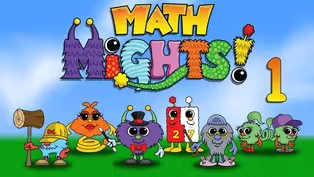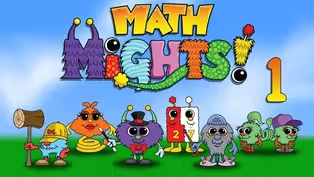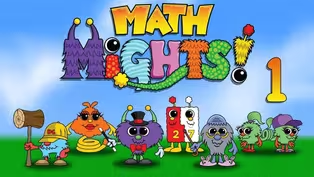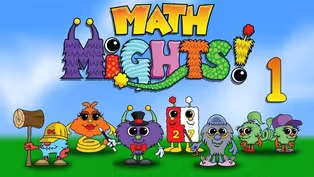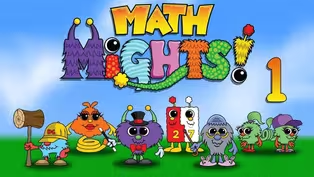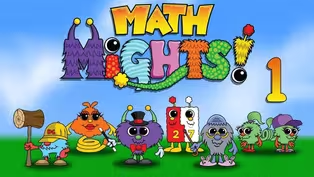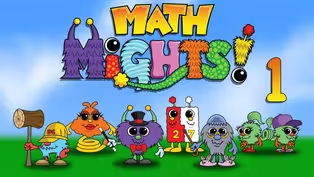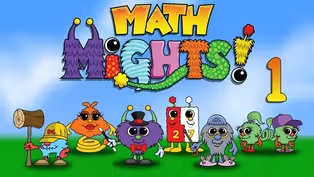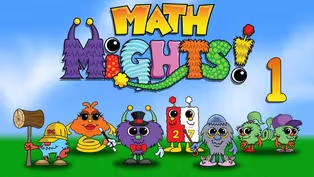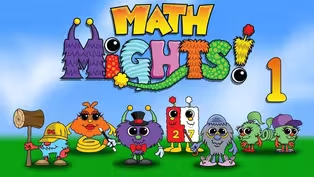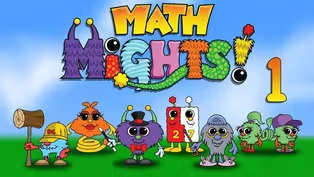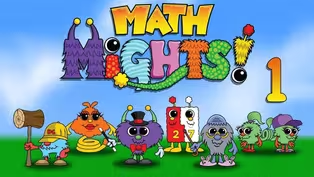Math Mights
Add 2-Digit Numbers
Season 3 Episode 304 | 15m 59sVideo has Closed Captions
Join Mrs. Markavich for a word problem with her friend Professor Barble!
Join Mrs. Markavich for a word problem with her friend Professor Barble! Next we will work on adding two-digit numbers and matching equations!
Problems playing video? | Closed Captioning Feedback
Problems playing video? | Closed Captioning Feedback
Math Mights is a local public television program presented by Detroit PBS
Math Mights
Add 2-Digit Numbers
Season 3 Episode 304 | 15m 59sVideo has Closed Captions
Join Mrs. Markavich for a word problem with her friend Professor Barble! Next we will work on adding two-digit numbers and matching equations!
Problems playing video? | Closed Captioning Feedback
How to Watch Math Mights
Math Mights is available to stream on pbs.org and the free PBS App, available on iPhone, Apple TV, Android TV, Android smartphones, Amazon Fire TV, Amazon Fire Tablet, Roku, Samsung Smart TV, and Vizio.
Providing Support for PBS.org
Learn Moreabout PBS online sponsorshipMore from This Collection
Video has Closed Captions
Join Mrs. Markavich for a missing addend word problem with Professor Barble! (16m 5s)
Adding Tens-Tens and Ones-Ones
Video has Closed Captions
Join Mrs. Markavich for a missing addend word problem with Professor Barble! (15m 35s)
Write Equations to Match the Strategy
Video has Closed Captions
Join Mrs. Markavich for a missing addend word problem with Professor Barble. (16m 2s)
Video has Closed Captions
Join Mrs. Markavich for a subtraction word problem with Professor Barble. (15m 59s)
Video has Closed Captions
Join Mrs. Markavich for a missing addend word problem. (16m 6s)
Add 2-Digit Numbers & Write Equations
Video has Closed Captions
Join Mrs. Markavich for a word problem with her friend Professor Barble! (15m 59s)
Comparing Numbers Different Ways
Video has Closed Captions
Value Pak shows you the different ways to compare 2-digit numbers. (15m 44s)
Video has Closed Captions
Join Mrs. Markavich for a word problem with her friend Professor Barble! (15m 59s)
Decompose/Compose #'s Different Ways
Video has Closed Captions
We show you different ways to decompose and compose 2-digit numbers! (15m 59s)
Video has Closed Captions
Join Mrs. Markavich & Dotson to talk about numbers with the Counting Buddy Senior! (16m)
Video has Closed Captions
Join Mrs. Markavich & Dotson for a Numeracy Talk with the Counting Buddy Senior (16m)
Video has Closed Captions
Join Mrs. Markavich for Numeracy Talk with Dotson working on conservation to 20. (16m)
Providing Support for PBS.org
Learn Moreabout PBS online sponsorship(dramatic orchestral music) (air swooshes) (magic chimes) (Springling boinging) (Dotsan screaming) - [Kids] Math Mights.
- Welcome Math Mights, Mrs. Markovich here, and we've got a whole lot of fun packed into today's show.
Let's take a look at our plan for the day.
Today, we will be doing word problems with Professor Barble.
We'll meet him in a little while.
Then we will be adding two-digit numbers.
I wanna warm up my math brain with my friend, Professor Barble.
He is going to conquer some word problem.
Professor Barble is a Math Might, and he lives in Mathville and he loves to solve math problems.
If he just slows down a little bit, pushes on his thinking cap, out comes a whole bunch of help.
There are some arrows on top that will lead him in the right direction to solve these word problems, and it will help him to slow down.
Let's talk about a visual model.
A visual model is sometimes known as a model drawing, a unit bar, a tape diagram or a bar model.
A visual model also helps with reading comprehension strategies for word problems.
And drawing a visual model helps to visualize or make that picture in your brain of the strategies and understand what the word problem is asking for.
Here's an example of what it would look like if you had it in front of you.
This is how I use it in my classroom.
Let's take a look at the first question.
It says this; Connor has eight baseballs.
He gave Jack three of his baseballs.
How many baseballs does Connor have left?
Ming says, "Oh, I think maybe we should add to solve this problem.
But Keshawn says, "Wait, or do we subtract?"
Professor Barble with all of his smart thinking tools says, "Whoa, guys!
Slow down."
We have some visual model steps that we can follow to make sure that we're solving this correctly.
Let's take a closer look at them.
The first step is to read the entire problem and put it in chunks or small groups.
So let's start by chunking it.
I'm going to read it first and then you're going to echo me.
Let's give it a try.
It says; Connor had eight baseballs.
Now you say it ready?
Go!
Connor has eight baseballs, chunk.
He gave Jack three of his baseballs.
Now you say it.
He gave Jack three of his baseballs, chunk.
How many baseballs does Connor have left?
Now you read it.
How many baseballs does Connor have left?
Chunk!
Our next step or step two is to rewrite the question into a sentence form.
This helps us slow down just like Professor Barble wants us to to think about what the answer is that we need.
It says; Connor has hmm baseballs left.
We need to figure out that hmm.
Step three says, we need to determine who or what is involved in the problem.
If you look at my example, you can see Connor is the who, and baseballs are the what.
The next step, step four, is to draw the unit bar.
The unit bar is this part right here.
Today, all of the sections are drawn in for you.
As we get stronger at solving these, those are going to disappear.
Step number five says, we need to check off the information as we chunk it.
So, we're going to check that off together on my big sheet in front of me.
Let's work on this together.
It says, Connor had eight baseballs.
There's that number eight, I'm going to add it to my visual model.
And I'm going to draw eight.
One, two, three, four, five, six, seven, eight.
I'm going to put the whole number eight at the end right here.
And then don't forget, check it off.
Let's move on to our next section that we chunked.
It says, he gave Jack three of his baseballs.
We're going to go over to this section and I'm going to write the word gave because Connor is giving some away.
So I'm going to write the word gave, this is called a label and it's really important to label your work.
And then I'm going to cross off the amount that he gave him.
So I'm going to cross off one, two, three.
And then don't forget, check.
Now, the next part says, how many baseballs does Connor have left?
Huh?
That's what this part must be.
This must be what Connor has left.
So I'm going to label it.
I'm going to write the word left and then, see that little line right there, that's the hmm.
That's the part I didn't know.
So I need to put a question mark on that part.
Question mark, and then, last but not least, don't forget to make the time check, check.
My next step is to compute or to solve the problem.
My friend says, "Now I see what the problem is asking.
I need to subtract because I crossed some off."
When I subtract, I start with a whole number and the whole number is eight.
So I'm going to I put eight minus the part that he gave away, which was one, two, three equals the hmm.
Here was my hmm.
Now it's time for us to count the hmm, let's do it.
One, two, three, four, five.
Five is what he had left.
And I don't wanna forget about the last part.
I have one more step.
Step number seven says, write the answer in the sentence and check.
I'm going to take the answer of five, that's what was left.
One, two, three, four, five, and I am going to write it right here.
Connor has five baseballs left.
Whoa!
That was some great thinking.
Now, it's time for our I can't statement of the day.
I can add two-digit numbers and find matching equations.
This is going to be great.
Let's go check it out.
My friends, Ming and Keshawn shared their answer for the sum of five plus 34.
Ming says, "I think the sum is 39."
Keshawn says, "I think the sum is 84."
Who do you agree with and why?
Hmm, I wonder what you came up with.
Did you come up with the same answer as Ming?
Or did you come up with the same answer as Keshawn?
Let's look a little closer.
How did Ming find her sum?
How did Keshawn find his sum?
I can see, five plus 34 equals 39, and then I can see Keshawn's, five plus 34 equals 84.
Huh, we need to investigate this sum more.
When I look at Ming's, she has five ones plus the number 34.
When you see here, I have five ones and four ones, and I know five add four gives me nine ones.
So I'm thinking five plus 34 equals 39.
But I haven't yet ruled out my friend Keshawn.
He might be right too.
Let's take a look at his.
He said, five plus 34 equals 84.
Five ones plus four ones would actually give me nine ones not four ones.
I think when I look at the tens, I think he actually added tens.
I think he added 50 plus 34 and that would give you 84.
I think what needed to happen was that he needed to add five plus 34 to give me the same answer that my friend Ming got of 39.
But that's okay Keshawn, don't stress out if you got it wrong.
Sometimes we make mistakes in math and that's okay.
We learn from our mistakes and we just move forward from it and try our best the next time.
Great job guys.
Now it's time to find the sum of 23 plus 45.
And Ming says, "Oh, I know how to do that.
I'm going to count by tens as I do it.
I'm going to start with 23 and then count on by tens."
She does this, 23, 33, 43, 53, and each time she's adding a 10, 63, and then she counts on by ones.
64, 65, 66, 67, 68.
Let's take a look at my board and work that through together, come on over.
23 plus 45 equals hmm.
There's the sum that I don't have yet.
We start with the number 23.
You can see the number 23 right here.
Ming adds by tens.
So we say, 23, 33, and I slide that under to see the number 33.
Keep counting, 43, and you can see each time my tens are changing, but my ones are not.
53, and 63.
Just like this.
Now you have to train your brain to stop counting by tens and count on by ones.
63, 64, 65, 66, 67, and 68.
I have one, two, three, four, six tens, and I have one, two, three, four, five, six, seven, eight ones.
So I know 23 plus 45 equals 68.
Great thinking Ming.
This time let's find the sum of 23 plus 45.
And what's really cool about math is that you can solve equations different ways.
Keshawn is solving the same problem a different way than Ming.
This time he starts with the 45 and adds 10 each time adding the 23.
So he says 45, he adds a 10 and says 55, adds another 10 and says 65, then he adds the ones.
66, 67, 68.
And he gets 23 plus 45 equals 68.
Let's take a closer look at that on my board and see how Keshawn solved this problem.
I have the same equation laid out.
23 plus 45 equals hmm, I don't have that part there yet.
You can see, I have tens and ones and the number 45.
We're going to start with the number 45 this time and add those tens.
So I'm going to say 45, 55, I'm gonna slide that under.
65, slide it under.
Again, my tens are changing, not the ones.
This time I'm going to add the ones.
So I have to stop counting by tens and continue counting by ones.
65, 66, 67, 68.
So I know that six tens and eight ones equals 68.
I'm going to write the solution at the top.
23 plus 45 equals 68.
Great thinking Keshawn and Ming.
You did a great job solving this equation in two different ways.
How are these methods and equations the same and how are they different?
I have it laid out for us.
Let's take a look.
I have Ming's on this side and Keshawn's on this side.
What you can see is that they both got the answer of 68.
So that's the similarity.
When we look at Ming's, Ming started with the 23 and added tens and ones to get to the answer of 68.
Keshawn started with the number 45 and added on tens and ones to get to the answer of 68.
They both used a different strategy, but they both got there in the exact same way.
Now it's my favorite part.
It's your turn to work on adding two-digit numbers with a 4 in a Row game.
I hope you have so much fun.
Thanks for joining me today, friends, we had so much fun with our friend Professor Barble who loves solving word problems and counting with tens and ones adding two-digit numbers and matching equations.
Whoa, that was a lot of work today.
I sure hope you'll join me next time on Math Mights.
Until next time, kiss your brains.
(upbeat music) (bright upbeat music) - [Kid] Sis4teachers.org, changing the way you think about math.
- [Announcer] This program is made possible with funding from the Michigan Department of Education Governor's education Emergency Funds the State of Michigan, and by viewers like you.


- Home and How To

Hit the road in a classic car for a tour through Great Britain with two antiques experts.










Careers that Work

Support for PBS provided by:
Math Mights is a local public television program presented by Detroit PBS
